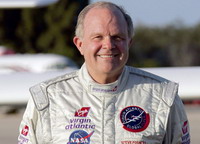Hopes to find Steve Fossett are very high
10 airplanes and helicopters started a fourth day of a search for missing millionaire adventurer Steve Fossett.

The pilots flew under clear skies, optimum conditions for trying to spot Fossett's single-engine plane.
"We're going to find this guy, but it's a big country," Civil Air Patrol Maj. Terry Vanzant said shortly before heading out.
Fossett disappeared Monday after taking off from a private airstrip to scout sites for an attempt at a land-speed record in a rocket-propelled car.
National Guard C-130s and helicopters with thermal imaging equipment searched the soaring peaks and sagebrush desert of northwest Nevada on Wednesday but failed to find anything new, Nevada Civil Air Patrol Maj. Cynthia Ryan said Thursday.
The search across more than 1,700 square miles (4,403 sq. kilometers) has covered only a fraction of the territory that could be hiding the plane. Ryan said the total area was 10,000 square miles (25,900 sq. kilometers), and finishing the fly-overs of the most likely landing spots could take another week.
Civil Air Patrol officials had said they were concentrating on an area of 600 square miles (1,554 sq. kilometers) but revised that Thursday to include the larger territory.
Fossett's friends and search leaders remain confident the world-famous adventurer is alive. They point to his experience climbing some of the world's best-known peaks, including the Matterhorn in Switzerland.
"If anyone has to be lost out there, this man has the skills to survive," Ryan said Wednesday. "With water, he could live out there for two weeks."
Fossett's plane, a Bellanca Citabria Super Decathlon, carried both water and food, but there also were troubling signs: The missing plane's locator device had not sent a signal, there had been no communication from the plane's radio, and an emergency wristwatch Fossett wore to signal his location had not been activated.
Ryan said Thursday that the terrain could make communication difficult and the emergency devices might not be able to send out a signal properly if Fossett was deep in a canyon.
Some veteran pilots speculated he may have fallen victim to the treacherous Sierra Nevada winds that squeeze through the narrow canyons.
"There's been times when I've been flying in the wind and my blood turns cold," said Adam Mayberry, a private pilot and former spokesman for the Reno-Tahoe International Airport.
On Wednesday, the searchers were briefly encouraged when one aerial team spotted a downed aircraft it believed was Fossett's. But a helicopter crew determined the wreckage was from one of dozens of old downed planes that litter the region's canyons.
Fossett is familiar with danger and high-octane rescues, after years of breaking - or attempting to break - speed and distance records on land and by air. He has held 116 such records.
Fossett aborted a 1996 attempt to be the first person to circumnavigate the globe in a balloon when his electrical system failed. He landed in a farmer's field near Maine.
In August 1998, Fossett's balloon crashed into the Coral Sea about 500 miles (805 kilometers) off Australia's coast during his fourth attempt to circle the globe. It plunged 29,000 feet (8,839 meters) after it was struck by hail and lightning during a fierce storm.
He was rescued by the crew of a yacht days later.
Fossett finally succeeded in circumnavigating the globe in a balloon in 2002, and three years later became the first solo pilot to circle the globe in an airplane without refueling.
Professor Ray Arvidson, chairman of the Earth and Planetary Sciences Department at Washington University in St. Louis, worked at the ground operations center for three of Fossett's balloon flights.
"I'm worried," Arvidson said, "but this guy is a survivor."
Subscribe to Pravda.Ru Telegram channel, Facebook, RSS!


